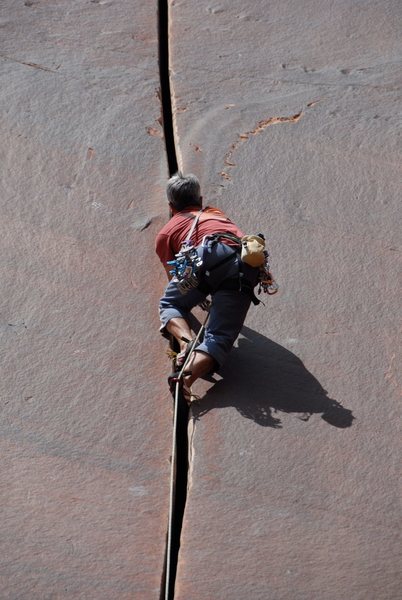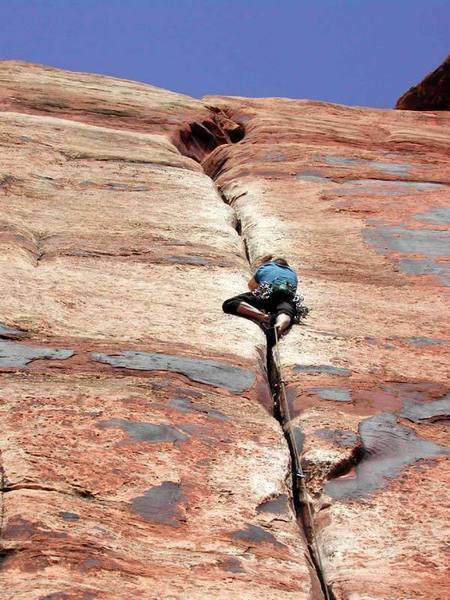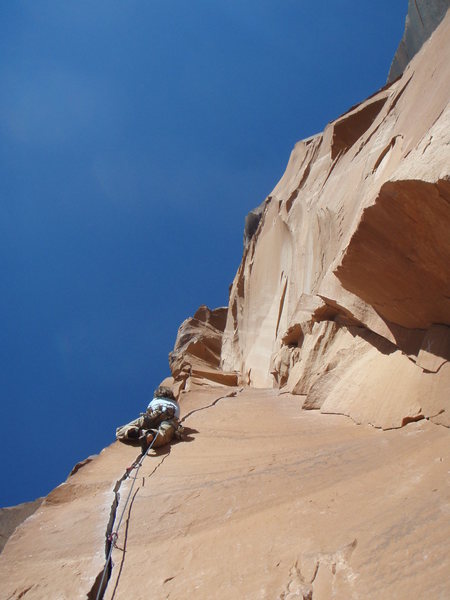Climbing splitters rope/foot management
|
|
While surfing through some pics on our beloved mtn proj and observations out at the crag I've noticed some different styles with foot placement in relation to the rope on straight-up cracks. There's actually a lot of examples out there. Once climbing above a placement some prefer to keep the rope to one side and some keep the rope between their legs. It's pretty obvious if the route leans to the left or right to keep the rope between the wall and climber, but what if the climb goes straight up? My concern is catching a foot on the rope in a fall. Even out at the crag there seems to be a disconnect on what is the best technique. Any evidence out there on what is the better technique? |
|
|
All of those cases are the same (save for the third photo...). We can't tell what the method is being used in the "no hands" photo (there may be pro clipped above the feet). |
|
|
Don't leave your rope between your legs on vertical splitters, especially if it's a rattly finger crack where your feet are never locked in well and you're insecure in general. When climbing splitters, the rope dangles behind your ankles by default, which means when you grease out, there isn't much opportunity to kick your legs out of the way. I know because this has happened to me a couple times. It takes a great deal of mindfulness to keep the rope to one side (and then the other) with each foot movement. Another way to visualize the problem is that if your feet are placed one over the other, your legs are essentially closed together or sort of crossed, which leaves nowhere for the rope except behind your legs and that is a vulnerable position. With careful foot placement, however, the rope will still run straight down from your harness, but just to the side of your foot, between you and the rock. The last photo of the guy on Swedin-Ringle is a good example of the best rope management. |
|
|
I think this is a good question. 2nd photo is probably the worst example, I'd say. Mainly because he's got a piece right there. |
|
|
D-Storm wrote:Don't leave your rope between your legs on vertical splitters, especially if it's a rattly finger crack where your feet are never locked in well and you're insecure in general.This is a good point. I thought the OP was referring to throwing the rope to the outside of the leg, not the foot. In the last photo, I still interpret it as being "between the legs." The subtlety you pointed out is definitely worth a mention. |
|
|
in general when i lead i try to keep the rope running over my hip on whicehver side. Helps keep it clear of my feet in cracks, and makes sure my ankle doesn't catch it should i try my luck at flying |
|
|
D-Storm wrote:Don't leave your rope between your legs on vertical splitters, especially if it's a rattly finger crack where your feet are never locked in well and you're insecure in general. When climbing splitters, the rope dangles behind your ankles by default, which means when you grease out, there isn't much opportunity to kick your legs out of the way. I know because this has happened to me a couple times. It takes a great deal of mindfulness to keep the rope to one side (and then the other) with each foot movement. Another way to visualize the problem is that if your feet are placed one over the other, your legs are essentially closed together or sort of crossed, which leaves nowhere for the rope except behind your legs and that is a vulnerable position. With careful foot placement, however, the rope will still run straight down from your harness, but just to the side of your foot, between you and the rock. The last photo of the guy on Swedin-Ringle is a good example of the best rope management.Ian, D-Storm's advice is spot on. Brian Prince wrote:I think this is a good question. 2nd photo is probably the worst example, I'd say. Mainly because he's got a piece right there.Agreed, the second photo is a perfect example of what not to do (if he fell, you can almost guarantee he is going inverted). However, this statement: Brian Prince wrote: I think, in reality, it normally doesn't matter and is impractical to constantly be thinking about it and placing your foot accordingly. I know I don't on straight in splitters. I also haven't taken many upside down falls.is not a good way to go about your business. Part of climbing under control is managing the rope and your feet. In fact it is one of the first things I notice when considering someone's style and competence (similar to placing ones feet deliberately and precisely). Catching your leg behind the rope is one of the surest ways to get yourself seriously hurt, yet its also one of the easiest dangers to remedy....it just takes care and mindfulness. |
|
|
Thanks for the comments! Sorry if my description wasn't clear, but it seems the point got acrossed. I was hoping to get some folks opinions on it and maybe open a few eyes on the potential for a bad fall. Basic rock climbing 101 teaches us to keep the rope between us and the wall, but when you start stepping one foot over the other on a splitter, it's not quite as cut and dry. It's crazy how many pictures there on here with potentially dangerous situations if the climber would have fallen. I guess to some it's obvious, but judging by all the pictures on mtn proj alone, it's certainly not common knowledge. |
|
|
wow, you should just get out and climb, you clearly have to much time on your hands. |
|
|
g.miller "wow, you should just get out and climb, you clearly have to much time on your hands." Yeah Ian, you're a real dick for trying to be safe so you can continue to "just get out and climb." Safety's for idiots. What's your problem!? ;) |
|
|
Alright my first flaming. I should have warned everyone: if you don't have time to read forum posts because it takes away from being out climbing and you enjoy getting flipped upside down or watching others bash their heads against the wall don't read this post. Safety third brah |
|
|
The most common error i seen with newer climbers is to have both legs wrapped around the rope especially on cracks ... You even see experienced people doing it on easy terrain ... Hell ive caught myself doing it |
|
|
Bearbreeder wrote: Ive personally seen several people flip and bash their helmets because of it ... There is no reason to do this, train youself to avoid it ... And if you are the belayer let them know |
|
|
I find this conversation odd. I've never had any real difficulty with the rope on cracks. Run it over your shin, think about what you'll look like in a fall, and keep on going. The only advice I'd mention is if you're in a spot that you can't get the rope in front of you, place a cam above you if you can. |
|
|
nicelegs wrote:I find this conversation odd. I've never had any real difficulty with the rope on cracks. Run it over your shin, think about what you'll look like in a fall, and keep on going. The only advice I'd mention is if you're in a spot that you can't get the rope in front of you, place a cam above you if you can. Sport on the other hand, is constantly finding a way to put the rope behind my leg. To make it worse, there are all these funny little foot moves that will lace up the legs way easier than the straightforward cracks. And the chance that I'll fall off any given move of a sport route is way higher.The problem IMO is that many moderate trad climbers rarely fall so they dont have alot of experience in how important not getting the rope caught between yr legs is Ill see plenty of experienced moderate climbers around who basically never fall, and honestly if they did they would flip headfirst onto a ledge Sport climber who climb at a decent level however tend to fall a decent amount ... And even right after showing them how to do trad, im impressed that the instictively place their feet where they wouldnt flip ... Theyve probably taken many falls in the past, some of them bad flippers Remember that flipping on moderatr ground is bad PERIOD, especially without a helmet ... Someone died on a fairly safe climb here a few years ago when a piece pulled, they flipped and bashed their head on the rock Thankfully all my flips and most the ones ive seen have been helmeted It only takes a flip or two to realize how important having a clean fall is ;) |
|
|
Since 'watch the leg' is a mouthfull, my verbal warning is 'Neckbrace!' |
|
|
Having the rope behind your leg doesn't automatically mean your bashing your head. Having taken a few for various reasons (rope behind leg, holds and pro ripping) I feel this is an area of expertise for me! If it's behind your ankle or calf your going to get some rope burn and little else, if the rope is running any higher up, use your abs so that your in a L or hamstring stretch position. Just like regular falls you can use your arms and legs to stay off the wall. |
|
|
|
|
|
A good way to understand where to put your feet is to think about the angle change of the rope during a fall. As you fall past your last cam, the rope will travel from running from your harness and below your feet, to from your harness and above you to the top piece of gear. Now visualize this imaginary line and understand that anything (Leg) crossing over this line will be carried upward with the rope when the fall and angle change are initiated. |

 Continue with onX Maps
Continue with onX Maps Continue with Facebook
Continue with Facebook































